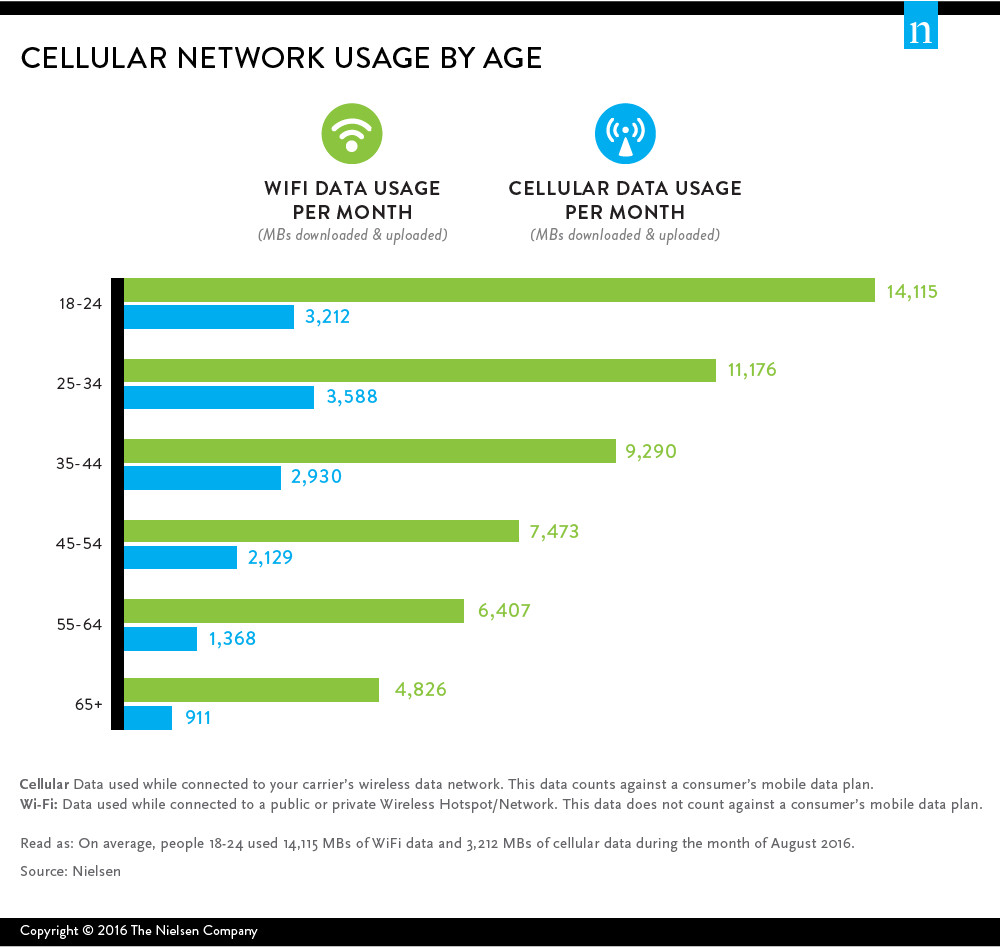Some say talk is cheap, but data overages sure aren’t. Exceeding the limit on a smartphone data plan is a monthly headache for many Americans. However, that doesn’t stop consumers from using their phones round-the-clock to stream their favorite TV shows, download music and hail cars. Data has now become a huge, often costly, obstacle for consumers to overcome.
But not everyone’s data usage is the same. These days, it’s no longer a one-size fits all mobile world. Insights uncovered by Nielsen’s Mobile Performance Panel during August 2016 reveal nuances in demographic and geographic data usage. These findings present an opportunity for carriers to improve consumer satisfaction by tailoring rate plans to fit specific usage needs and demands.
In second-quarter 2016, Nielsen Billing Snapshots showed that 6.6% of mobile Android consumers were faced with overage charges. So in an effort to curb those extra charges, many are turning to Wi-Fi. In fact, they use more than 3 times as much Wi-Fi data as cellular. According to Nielsen Mobile Insights, third-quarter 2016, 10% of those who exceeded their monthly data limit consider switching to another provider in order to get a better deal on data.
DATA ON AGE USAGE VARIES ACROSS WI-FI AND CELLULAR NETWORKS
Millennials drive much of this heavy data usage. Specifically, 18 to 24 year olds drive much of it. As Millennials enter the work force and purchase data plans, they start to use more cellular data than their younger counterparts.

HISPANIC CONSUMERS ARE THE HEAVIEST DATA USERS
Without a doubt, Hispanics are the heaviest data users among multicultural groups. Over one-third of their data usage comes from cellular data. Nielsen also found that Hispanics have the highest level of satisfaction with their mobile providers. As the most avid data users and a fast growing demographic in the U.S., carriers need to keep the Hispanic consumer top of mind.
There are clear differences in usage among other multicultural groups. Asian-Americans hold second place for Wi-Fi usage, while black Americans use more cellular data per month than Asian-Americans. Although Alaskan and Native Americans use the least Wi-Fi, they are heavy cellular data users, as one-third of their usage comes from cellular data. With these unique characteristics in mind, networks should design and market data plans desirable to multicultural segments of the population.

CITY BY CITY, A LOOK AT DATA USAGE ACROSS MAJOR U.S. MARKETS
What do public transportation, traffic, Wi-Fi access and weather all have in common? They each affect data usage across the U.S.
Public Wi-Fi is great—when it exists, that is. Consumers in New York, Boston and Washington, D.C., use more Wi-Fi than the average across the country. As a result, they use less cellular data. When New Yorkers get on the subway for their evening commute, they lose nearly all cellular connection. However, New York, Boston and D.C. have all started implementing Wi-Fi on their subways, soon to make the commute a bit more web friendly.
How about traffic? Consumers in commuter cities like Dallas, Houston and Los Angeles all use more cellular data than average. And long-distance commuters drive more than just their cars. They drive steep cellular data usage as well.
The weather can also affect plans—carrier plans that is. Across the board, consumers in warmer climates use more cellular data and less Wi-Fi, as consumers are likely out and about and away from their home Wi-Fi routers.
With data at a premium these days, consumers are finding ways to make their mobile phones work for them. The rise in public Wi-Fi hotspots and changing data plans will continue to diversify the mobile marketplace. While consumer usage is unique across demographics and markets, one thing is certain: Americans are obsessed with their data.

Methodology
Nielsen Mobile Performance (NMP): Data usage based on 45,000 U.S. based Android Users (age 18+) measured in the panel for the month of August 2016. “Usage” is defined as a data transfer: a download (of at least 150KB) or upload event (of at least 100KB) over a data network, either Wi-Fi or cellular.
Cellular: Data used while connected to your carrier’s wireless data network. This data counts against a consumer’s mobile data plan.
Wi-Fi: Data used while connected to a public or private Wireless Hotspot/Network. This data does not count against a consumer’s mobile data plan.
Nielsen Billing Snapshots: Billing Snapshots measures billed usage and spend for post-paid telecom customers, by collecting data on actual bills of 3000 respondents per month.
Nielsen Mobile Insights: Nielsen’s Mobile Insights is a monthly survey of 30,000+ US mobile subscribers aged 13+. Data is collected primarily online and via in-app mobile. Additionally, a supplemental Spanish language phone version is fielded among Hispanics aged 18+.


